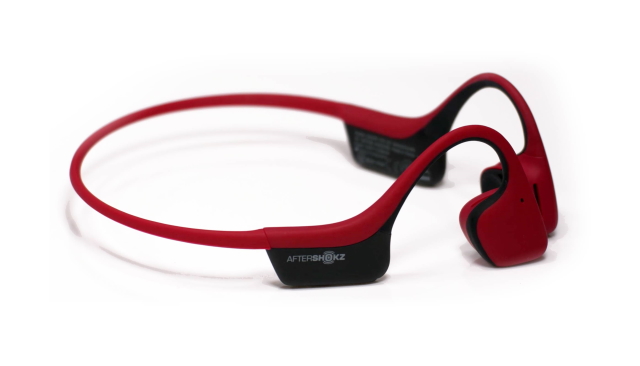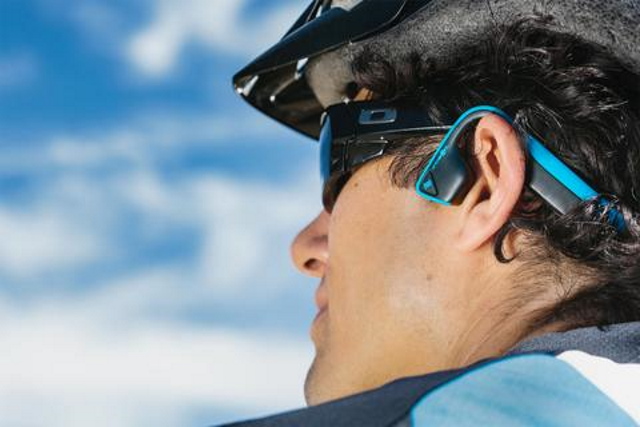Bone Conduction Headphones
While we will begin by explaining what bone conduction headphones are, we will also cover the various concepts around them including answering any questions you may have. Have a look at the table below and jump to the section you feel is relevant to you.
What Exactly Is Bone Conduction
To understand what is bone conduction, we need to understand how sound travels to your ears, to begin with. In layman’s terms, the concept of Sound essentially is nothing more than mini vibrations in the air. These vibrations then travel to our ear through our eardrums and the bones in our skull.
Normal day-to-day hearing and traditional headphones rely on making sure these vibrations go through our eardrums which in turn vibrate themselves. These vibrations are then relayed to the cochlea (inner ear). Our inner ear sends these signals to our auditory nerve and in turn our brain. This is how we hear when other people talk to us and how we listen to sound in general.
Bone Conduction however is focused on a similar concept but instead does not rely on our eardrums. Bone conduction technology creates sound waves that our inner ear can directly receive. The sound that reaches us as vibrations go through the bones in our skull and even our skin.
Discovered by Ludwig van Beethoven who used to hear his compositions by clenching a rod in his mouth that was attached to his piano, bone conduction technology relies on the bones of our skull while doing the same job. This is also one of the ways we can hear our own voice.
How Do Bone Conduction Headphones Work
Bone conduction headphones leverage the bones near our inner ear (jaw and skull bones). Sitting outside our ears, bone conduction headphones contain a special driver that creates the vibrations our cochlea needs without using the eardrums. These vibrations then travel directly from the headphones to our inner ear and then are converted to sound by our brain.
Whereas traditional headphones send vibrations to our eardrums to start the conversion process, bone conduction headphones send already converted vibrations to our inner ear. They do this by using what is known as built-in transducers. This way the eardrums are cut out of the equation and bone conduction enters the conversation.
However, since this process relies on the bones near our ears, you will find bone conduction headphones shaped differently. This design is aimed at placing the headphones comfortably around the back of our heads so that the process isn’t interrupted.
Are Bone Conduction Headphones Safe
Many people are skeptical of bone conduction headphones since the technology is relatively new. But, you don’t need to be worried as bone conduction headphones are as safe as any other pair of headphones you will find on the market. However, that does not mean that they don’t cause any damage at all.
Like everything else in life, too much sound is harmful to our ears. Bone conduction headphones spare our eardrums and keep them safe. However, like all headphones, if you have them on for too long and play them too loud, bone conduction headphones can cause permanent damage to your inner ear.
The key to using them safely is like any other pair of headphones. Use bone conduction headphones in moderation and when you do, make sure the volume isn’t set too high. Practicing this will keep your ears safe and out of trouble.
How Is the Sound Quality of Bone Conduction Headphones
The sound quality of bone conduction headphones admittedly isn’t as amazing as you would find on similarly priced traditional headphones. The primary reason for this is the placement. Since bone conduction headphones are placed outside the ears and around our heads, the sound has to travel a bit further. Moreover, since the eardrums are left open, all the ambient noise around us finds its way inside our ears thereby decreasing immersion.
However, that is not to say bone conduction earphones have terrible sound quality. Recent advancements in this technology have allowed companies to create headphones that offer a very competitive balance of sound quality and price despite the design. Furthermore, companies have actually gone a few steps above and beyond in this pursuit. One of the most bizarre things we have seen are these water-filled bone conduction headphones that use water as the primary carrier.
While bone conduction headphones will not offer you the sound quality rivaling Sony WH-1000 XM4 or the WF-1000 XM4 that we reviewed, they will provide a fair balance between them. However, if you’re an audiophile who only wants the best then we suggest you skip getting a pair.
How’s the Battery Life of Bone Conduction Headphones
Bone conduction headphones offer the same amount of battery life as traditional ones. Whether you are going for headphones the likes of AfterShokz Aeropex or any other brand, you will easily get 6-10 hours of battery life depending on your use case. Moreover, like any other headphones, bone conduction ones come with their own charging cable so you can top up whenever low.
Who Can Get Bone Conduction Headphones
While anyone out there can go get themselves a pair of these headphones, there are some people who are better suited. The primary appeal of bone conduction headphones is their ability to provide situational awareness. Therefore people who like to be aware of their surroundings while listening to music can get a pair of bone conduction headphones. Moreover, athletes and runners who would like to train while being present in risky environments can definitely pick up a pair.
Bone conduction headphones are also a good pick for individuals with slight to moderate hearing damage. Since these headphones rely on outer bones instead of eardrums, people with hearing damage can safely put them to listen to music. However, even in this case, they should only use moderate to low volume and for lower periods of time.
And finally, working professionals in offices that need attention can get bone conduction headphones. This can help strike that perfect balance for when you want to listen to music while also leaving room for your co-worker calling for you a few tables away.
And as we said before, audiophiles or gamers looking for an unparalleled experience should stay away. Check out these best gaming headsets if that’s what you’re after.
Pros and Cons of Bone Conduction Headphones
So now that you finally understand what exactly bone conduction headphones are and what they do, it’s time to weigh in the pros and cons. We have divided the pros and cons below so make sure to read them all before you reach a decision.
How Do I Wear Bone Conduction Headphones
The primary rule here is that bone conduction headphones must always be worn around your neck. The transducers which is the part responsible for creating the correct vibration must be placed in front of the ears and not on them. This way the headphones are in front of your outer ear. Under no circumstances, should these headphones be worn on or over the ears.
- Increased Situational Awareness There’s no doubt that it’s incredibly risky listening to music while you jog on the sidewalk or are on public transport. Bone conduction headphones take this problem away entirely. Since your ears are not covered, bone conduction headphones leave all the room for outside noise to come in while you listen to music. This means you’ll still be able to hear vehicles around you honk or people calling you while you are deep in a rock song.
- Hearing Loss Friendly People with hearing loss are advised to stay away from loud noises and most definitely headphones. Bone conduction headphones provide a safer way for people with hearing loss to listen to music and take calls while they heal from their ordeal. Moreover, if you’re someone who wants to be proactive and take good care of your ears, then these are for you.
- More Comfortable Fit It is difficult to find a pair of headphones or earphones that are just right for you. While some people don’t like plastic earbuds because of a bad fit, many find silicone-tipped ones too intruding. Bone conduction headphones comfortably fit around the back of the head thereby not being too loose or tight. Moreover, they are almost guaranteed to never fall off mid-activity which is something many earbuds suffer from. This also helps in times when you just cannot find the other earbud.
- Wireless Freedom Since bone conduction headphones are fully wireless and based around Bluetooth, they don’t require users to connect them through wires or special attachments. Just a simple Bluetooth connection and you’re all set.
- Decreased Sound Quality As we have discussed before, bone conduction headphones leave the eardrums and the canal open to any and all ambient sounds. While this is beneficial to hear what’s going on around you, it also works the opposite way. If you’re a user who wants to just focus on the music and be lost in it, you will sadly be pulled out of that immersion over and over again depending on where you are. Whether it’s a loud horn that goes past your ear or someone shouting next to you, bone conduction headphones will fall short of the best audio experience.
- More Expensive Compared to Traditional Headphones While bone conduction technology was apparently discovered long ago, the commercialization and production of headphones are still relatively new. Since this is a technology that isn’t bought and used by everyone, it is naturally expensive. Therefore, if you’re looking for headphones priced in an affordable range, you’re better off sticking to traditional over-the-ear ones.
- Still Prone to Hearing Damage While it is proven that bone conduction headphones are safer than your everyday ones, they can still cause damage to your inner ear. This can especially happen if misinformed customers think they are immune to hearing damage. No matter what type of headphones, you will need to listen to music at a reasonable volume to stay safe. So if you’re thinking of getting a bone conduction pair just because you feel they are totally safe, think again. The frame itself should not be too tight and should actually be a bit loose. Don’t worry if it feels too loose as you can always tilt it around to get a comfortable fit. Depending on what company and model you have, there will be specific instructions on how to go about this. Always read the instruction manual to achieve a more tailored fit.
1. Can I Use Bone Conduction Headphones for Calling?
Yes, you can. While bone conduction headphones work differently than traditional ones, they too contain microphones to capture your voice and relay it across. So you can easily use them for calling whether it’s voice or video. You can further use them across communication apps like Discord or Slack or simply YouTube.
2. Do I Need Special Hardware to Use Bone Conduction Headphones?
No, you don’t. All you need is a phone with Bluetooth 4.0 and over. Once you have that, you can easily pair your phone with the headphones and begin your music listening journey.
3. Can Bone Conduction Headphones Cause Tinnitus?
On the contrary, they can actually help manage Tinnitus. For the ones who don’t know, Tinnitus is a ringing or buzzing noise that hearing damage stricken patients experience. Since the condition is chronic, it can be very bothersome. Provided you listen to music at reasonable levels, these headphones can help alleviate the symptoms of tinnitus.
4. Do Bone Conduction Headphones Work with Hearing Aids?
Yes, they do. While regular headphones and earbuds can get in the way of hearing aids, bone conduction ones do not. So if you’re a person who is hard of hearing and you use hearing aids, you can safely go for a pair of bone conduction ones and enjoy.
5. Are Bone Conduction Headphones Fit for All Head Shapes?
While most bone conduction headphones fit all head shapes, there are people who might disagree. However, most modern bone conduction companies offer headphone frames that can be adjusted to fit your fit. Nevertheless, we advise visiting your favorite electronic store and trying out a pair before you break out your wallet.
Be More Aware with Bone Conduction Headphones
We hope you now know everything you wanted to about bone conduction headphones and how they work. However, if you’ve decided that this tech isn’t your fit, don’t worry. Audiophiles looking for that premium sound can go for these best audiophile headphones. Users looking for immersion can check these best noise-canceling headphones out. Got questions about something? Ask them in the comments below!


